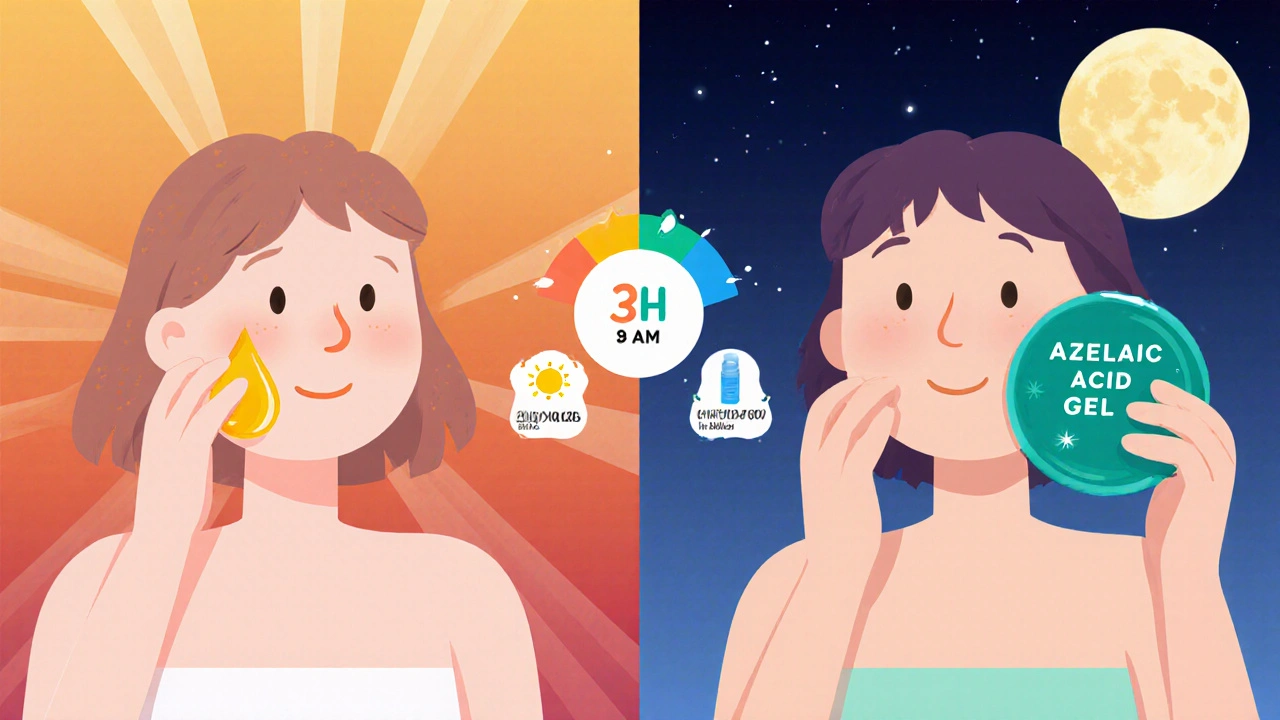Skincare pH Compatibility Checker
How It Works
Azelaic acid works best at pH 4-5, while vitamin C requires a more acidic environment (pH 2.5-3.5). This tool checks if your products are compatible for safe combination.
Ever wonder why your skin sometimes feels stuck between battling breakouts and fading dark spots? The answer often lies in the actives you’re using - and pairing the right ones can turn a frustrated routine into a breakthrough. Azelaic acid and vitamin C are two powerhouse ingredients that, when combined correctly, tackle inflammation, oxidation, and uneven tone without the drama of harsh peels or risky mixes.
What is Azelaic Acid?
Azelaic Acid is a naturally occurring dicarboxylic acid found in grains like barley, wheat, and rye. It was first introduced to dermatology in the 1980s as a treatment for rosacea and acne. Its molecular structure lets it inhibit the growth of Propionibacterium acnes bacteria, reduce keratin overproduction, and calm inflammation. In other words, it unclogs pores, smooths texture, and brightens skin by gently fading post‑inflammatory hyperpigmentation.
Vitamin C Explained
Vitamin C (L‑ascorbic acid) is the most researched antioxidant for skin. It donates electrons to neutralize free radicals generated by UV exposure, pollution, and stress. Beyond protection, vitamin C boosts collagen synthesis by activating pro‑line hydroxylase, which gives skin its firmness. The result? A visible reduction in fine lines, a more even complexion, and a radiant glow that looks like you’ve just walked out of a spa.
Why These Two Click Together
Most people think mixing actives is a recipe for irritation, but azelaic acid and vitamin C actually complement each other in three key ways:
- pH harmony: Azelaic acid works best at a pH of 4‑5, while vitamin C prefers a more acidic environment (pH < 3.5). When you apply them at different times of the day, each can operate in its optimal zone without fighting for the same pH level.
- Dual‑action on pigment: Vitamin C stops melanin formation by inhibiting the enzyme tyrosinase, whereas azelaic acid interrupts melanin transfer to skin cells. Together they attack dark spots from both the production and distribution angles.
- Balanced inflammation control: Vitamin C’s antioxidant shield reduces oxidative stress, while azelaic acid’s anti‑inflammatory properties calm redness. This combo is especially friendly for rosacea‑prone or acne‑sensitive skin.

Stacking Them Safely: Timing and Technique
Here’s a simple, no‑guesswork routine that works for most skin types:
- Morning: Cleanse with a gentle pH‑balanced cleanser (around 5.5). Pat dry, then apply a few drops of a stable Vitamin C serum. Wait 1-2 minutes for absorption, follow with a broad‑spectrum sunscreen SPF 30+.
- Evening: After cleansing, tone if you use an alcohol‑free toner. Apply a pea‑sized amount of Azelaic Acid (10% gel or cream) to the entire face or spot‑treat trouble areas. Finish with a lightweight moisturizer that contains ceramides to reinforce the skin barrier.
For those who love a single‑step routine, consider a product that already blends azelaic acid with a low‑dose vitamin C in a time‑release formula. These hybrids keep the pH stable and reduce the need for multiple applications.
Best Routines for Different Skin Concerns
Not every skin goal needs the exact same approach. Below are three tailored combos.
- Acne‑prone skin: Focus on a 10% azelaic acid gel nightly; keep vitamin C at a concentration of 5% in the morning to avoid over‑drying. Pair with a non‑comedogenic moisturizer containing niacinamide for extra sebum regulation.
- Hyperpigmentation & melasma: Boost vitamin C to 15% for daytime use (if your skin tolerates it) and use a 15% azelaic acid cream at night. Add a weekly exfoliating mask with lactic acid to accelerate cell turnover, but skip it on the same night as azelaic acid.
- Anti‑aging focus: Keep vitamin C at 20% in the morning for collagen support, and use a 10% azelaic acid cream at night to improve texture. Top off the routine with a peptide‑rich night cream for synergistic firming.

Potential Pitfalls and How to Dodge Them
Even the best duo can go wrong if you overlook a few basics:
- Skipping sunscreen: Vitamin C can make your skin more sensitive to UV rays, and azelaic acid doesn’t provide any sun protection. Sunscreen is non‑negotiable.
- Layering with strong acids: Avoid using glycolic or salicylic acid in the same step as azelaic acid. If you love chemical exfoliation, reserve it for a separate evening or use it a few times a week, not daily.
- Over‑application: More isn’t always better. Stick to the recommended pea‑size amount for azelaic acid and a few drops for vitamin C. Excess can disrupt the skin barrier and cause tingling.
- Ignoring pH compatibility: If you switch to a vitamin C serum with a higher pH (around 6), you lose much of its antioxidant potency. Look for formulations that guarantee a pH < 3.5.
Quick Comparison: Azelaic Acid vs. Vitamin C vs. Retinol
| Attribute | Azelaic Acid | Vitamin C | Retinol |
|---|---|---|---|
| Primary Action | Anti‑inflammatory, keratolytic, melanin transfer inhibitor | Antioxidant, collagen booster, tyrosinase blocker | Cell turnover accelerator, collagen synthesis |
| Ideal pH | 4‑5 | <3.5 | 5‑6 (when in stable forms) |
| Best For | Acne, rosacea, melasma | Hyperpigmentation, dullness, anti‑aging | Fine lines, texture, severe discoloration |
| Typical Concentration | 10‑20% | 5‑20% | 0.1‑1% |
| Irritation Risk | Low‑moderate (especially at 20%) | Low‑moderate (higher at >15%) | High (especially without moisturizers) |
Notice how azelaic acid and vitamin C target similar concerns but with different mechanisms? That’s why using them together gives you broader coverage without the irritation you might see from stacking retinol and strong acids.
Mini‑FAQ
Can I use a vitamin C serum and azelaic acid in the same routine?
Yes, but keep them at opposite times of day-vitamin C in the morning and azelaic acid at night. This prevents pH clashes and lets each ingredient work at its optimal level.
Will the duo work on rosacea?
Azelaic acid is a first‑line treatment for rosacea because it reduces redness and inflammation. Adding vitamin C can further calm oxidative stress and improve skin tone, making the combo very rosacea‑friendly when you use a gentle, fragrance‑free formula.
How long does it take to see results?
Most users notice a smoother texture and reduced redness within 2‑3 weeks. Significant fading of dark spots usually needs 8‑12 weeks of consistent use, especially for stubborn melasma.
Is it safe to combine this duo with sunscreen?
Absolutely. In fact, sunscreen is essential because both ingredients increase photosensitivity. Choose a mineral‑based SPF 30+ that doesn’t leave a white cast.
Can I apply both products if I have sensitive skin?
Start with a lower concentration-5% azelaic acid and 5% vitamin C-and patch‑test for 48 hours. Gradually increase as tolerated. Pair with a calming moisturizer containing hyaluronic acid and ceramides.
Ready to give your skin the double boost it’s been craving? Remember: consistency, sunscreen, and listening to how your skin reacts are the three pillars of success. With azelaic acid and vitamin C working side by side, you’ll see clearer, brighter skin that feels as good as it looks.







Javier Muniz
October 23, 2025 AT 21:39